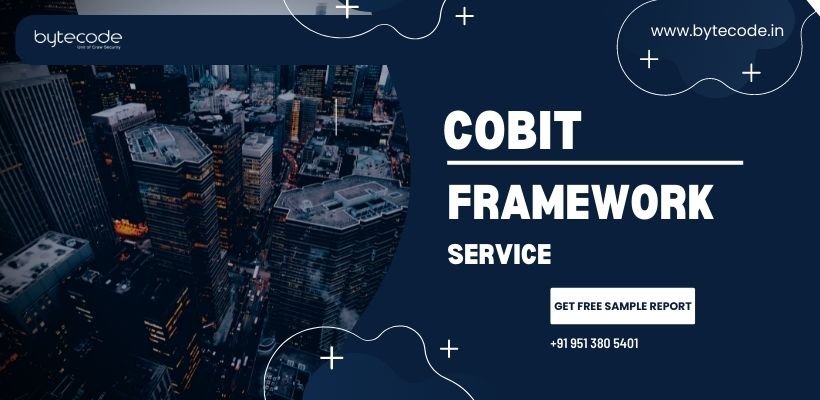COBIT Framework Service in India
The acronym of COBIT stands for Control Objectives for Information and Related Technology, which is a framework that is technically used for identifying the framework’s name. The COBIT Framework is basically a comprehensive framework of concern and applicability to all IT stakeholders. Moreover, organizations have adapted this hierarchy of COBIT Framework to align their IT majors with the enterprise objectives globally, hence, executing IT Governance endeavors. In addition, COBIT Framework is drafted and initiated by ITGI – a body of worldwide-acclaimed professionals in the domain.

What is COBIT Framework?
In short and simple words, COBIT Framework is generally referred to as a comprehensive framework of interest and applicability to all IT stakeholders, which was initially derived by ITGI – a globally-recognized experts’ body in the field. In addition, many businesses technically adapted this framework to align their IT objectives with the organization’s objectives at a worldwide level, thus, implementing IT Governance aims.
What is COBIT Framework Used For?
Bytecode Security, the best VAPT Services Provider in India, offers many variedly dedicated solutions and services with the help of the COBIT Framework that can be very crucial and helpful for the business in the Indiaan market to have a safe listed connection with the global market so far. In this regard, some of the prominent servers are mentioned below:
- Entire COBIT Implementation.
- Gap Analysis Best Practices.
- COBIT — affiliated training and workshops.
- Best COBIT Exercises.
- Commixing COBIT with additional measures and frameworks.
- Enforcing and utilizing the COBIT Capability Model.
- COBIT-focused Third Party Control Self Inspections
- COBIT-focused Audits
- IT Risk Estimations strictly based on Best COBIT Exercises
- Security baselining activity with COBIT
COBIT Risk Management Benefits
There are some benefits of employing the COBIT Framework in this modern technology-based market where several data breach incidents happen every following hour. Hence, the realization of these advantages of the COBIT Framework comes with the correct blend of skills, knowledge, resources, and motivation. In addition, the best method to understand all the benefits is to execute the framework.
Moreover, we have jotted down some of the prime benefits that one will get while using our primetime COBIT Framework Service in India:
- Firstly, COBIT endeavors to support an organization complete its enterprise pursuits via IT as its backbone.
- In addition, COBIT exercises to aid in executing good IT Governance.
- COBIT supports saving aids via the procedure, application, people, and infrastructure coalition.
- COBIT assists with connecting special IT exercises to entire organization control models (e.g., COSO and Coco).
- COBIT was conceptualized with a genuine audit concentration and has matured to an IT Governance concentration – thus, the COBIT framework has become the proven portrayal of the advancing best IT exercises.
- COBIT assists in tracking down any considerable methods of IT enforcement, thus permitting senior management to evaluate return on investment on IT expenses.
COBIT 5 Service Management
In the technical protocols, certain parameters are established for the organizations that assist them in meeting organizational challenges in controlled compliance, risk management, and implementing IT strategies with organizational goals. Moreover, COBIT® 5, the latest version of this most-wanted framework, was released in the year 2012.
In addition, the chief COBIT 5 Principles of COBIT 5 Service Level Management that assist organizations worldwide in meeting their business targets with a promising factor are mentioned below in the following table:
| Principle 1 | Meeting stakeholder needs. |
| Principle 2 | Covering the enterprise end-to-end. |
| Principle 3 | Applying a single integrated framework. |
| Principle 4 | Enabling a holistic approach. |
| Principle 5 | Separating governance from management. |
Frequently Asked Questions
What are the 5 principles of COBIT?
The prominent 5 principles of COBIT are as follows:
- Principle 1: Meeting stakeholder needs.
- Principle 2: Covering the enterprise end to end.
- Principle 3: Applying a single integrated framework.
- Principle 4: Enabling a holistic approach.
- Principle 5: Separating governance from management.
What is difference between ITIL and COBIT?
The basic difference between ITIL and COBIT can be described as ITIL is more operational, generally focusing on service management and delivery, while COBIT is highly structured, strategic, and sincerely focused on good IT Governance.
Moreover, ITIL focuses on optimizing IT services to best handle the business, while COBIT leans more towards aligning IT objectives and values with enterprise missions.
What are the 3 parts of COBIT approach?
The highlighted 3 parts of the COBIT Framework approach are as follows:
- Organize and categorize IT governance objectives,
- Good practices by IT domains, and
- Functioning on various processes before associating them with their respective business requirements.
Who should use COBIT?
COBIT Framework could be used by every organization, whether hailing from the Government, Public, or Private sector, as it assists in enhancing the sensibility of distinguished IT operations.
What are the four domains of COBIT?
The COBIT Framework defines many IT procedures in a most common methodology within the four primetime domains of the COBIT Framework that are as follows:
- Plan and Organize,
- Acquire and Implement,
- Deliver and Support, and
- Monitor and Evaluate.
Is COBIT still relevant?
Yes, even in today’s technology-based world, the COBIT Framework is genuinely used by many IT business process managers at a global level to furnish them with a model to deliver value to the enterprise and practice better risk management exercises associated with the IT functions.
Is COBIT a risk management framework?
In general terms, Risk Management is embedded in the COBIT® 5 Framework, whereas the IT governance process aims to confirm that IT-based enterprise risks do not exceed the risk tolerance level. However, Risk to enterprise value is strictly concerned with IT usage, and its impact is tracked down and controlled in a sophisticated manner.
What are the COBIT processes?
The varied COBIT processes can be defined as a particular life cycle of planning, designing, building, operation, monitoring, and updating.

